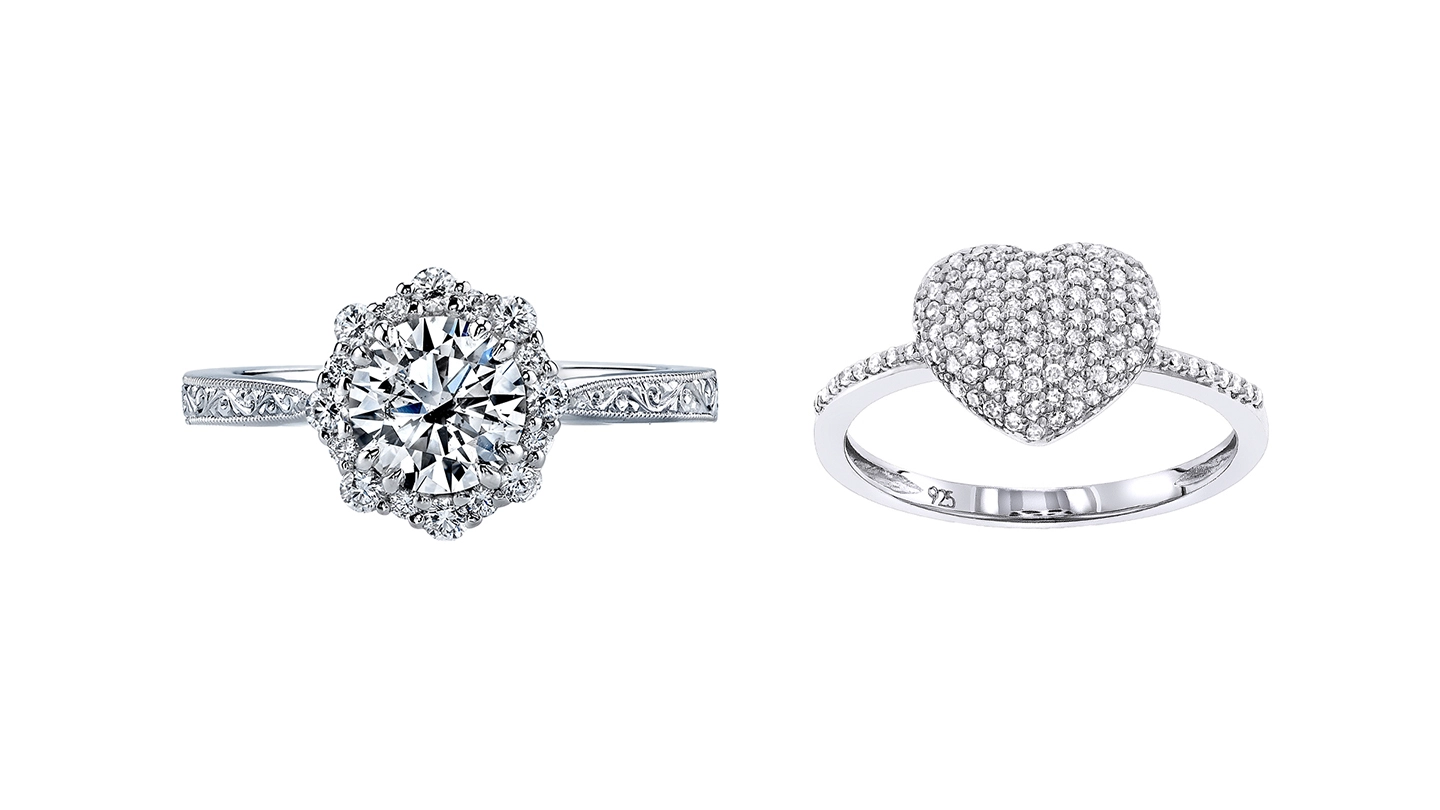Courtesy of evelynH Jewelry Inc. (left) and ItsHot.com (right)
The white gold ring on the left is set with a large diamond center stone. The silver ring on the right is set with melee diamonds.
Among the many options for jewelry metals, white gold and silver emerge as popular favorites for their unique properties and stunning aesthetics. Whether you’re drawn to the radiant sheen of white gold or the classic elegance of silver, each metal brings its unique flair to a range of jewelry designs, offering distinct alternatives to the traditional yellow gold.
While both metals offer elegance and versatility, they have unique benefits and considerations. In this comprehensive guide, we’ll help you understand the nuances of white gold and silver, ensuring you make an informed choice for your next piece of jewelry.
What is White Gold?
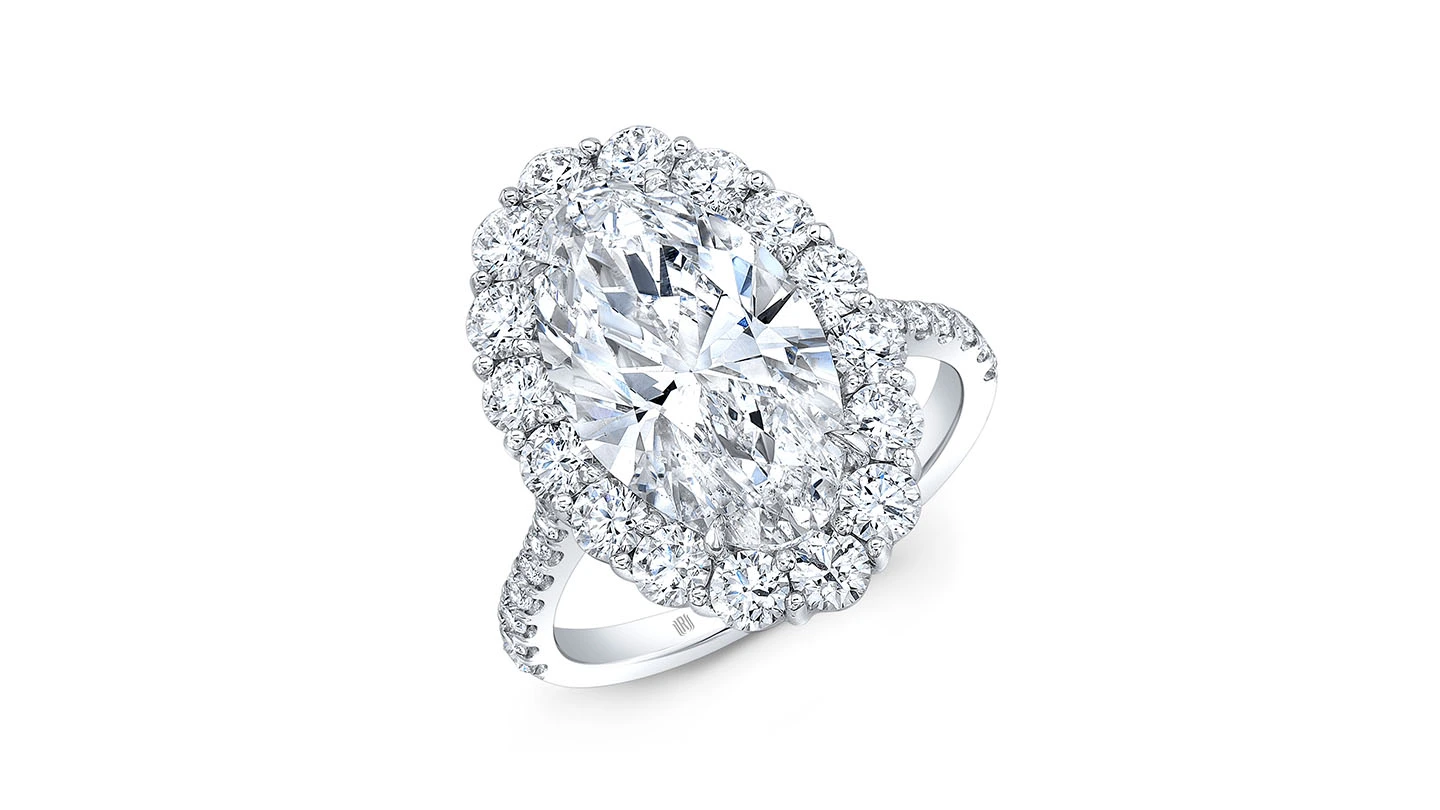
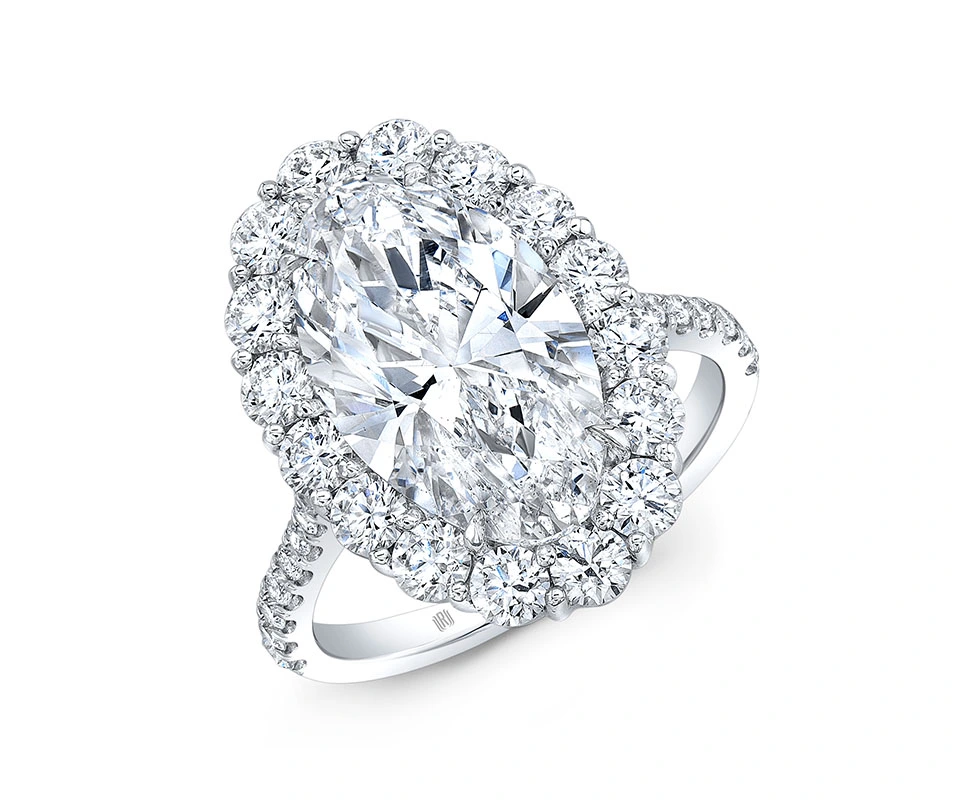
White gold is valued for its brilliant luster and durability. It is made by mixing pure gold with white metals like nickel or palladium and often coated with rhodium for extra shine, bright white color and scratch resistance.
The purity of white gold, measured in karats, influences its value. Among the varieties, 14K and 18K white gold are the most popular choices for jewelry. 14K white gold offers a balance of durability and gold content, making it ideal for everyday wear. In contrast, 18K white gold, with higher gold content, is somewhat softer and, if not coated in rhodium, can appear warmer in color. It is often used in high-end jewelry to set more valuable stones.
What is Silver?
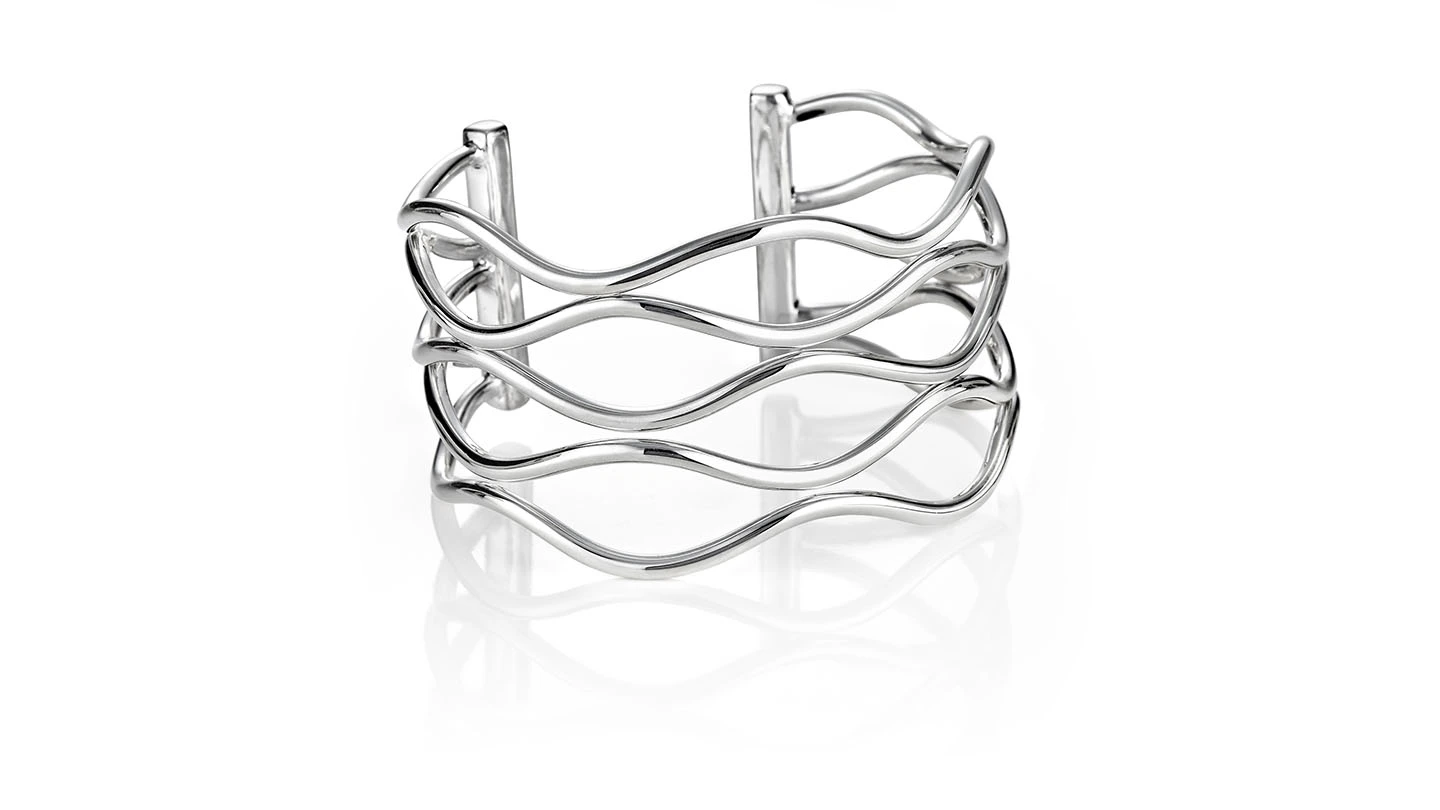
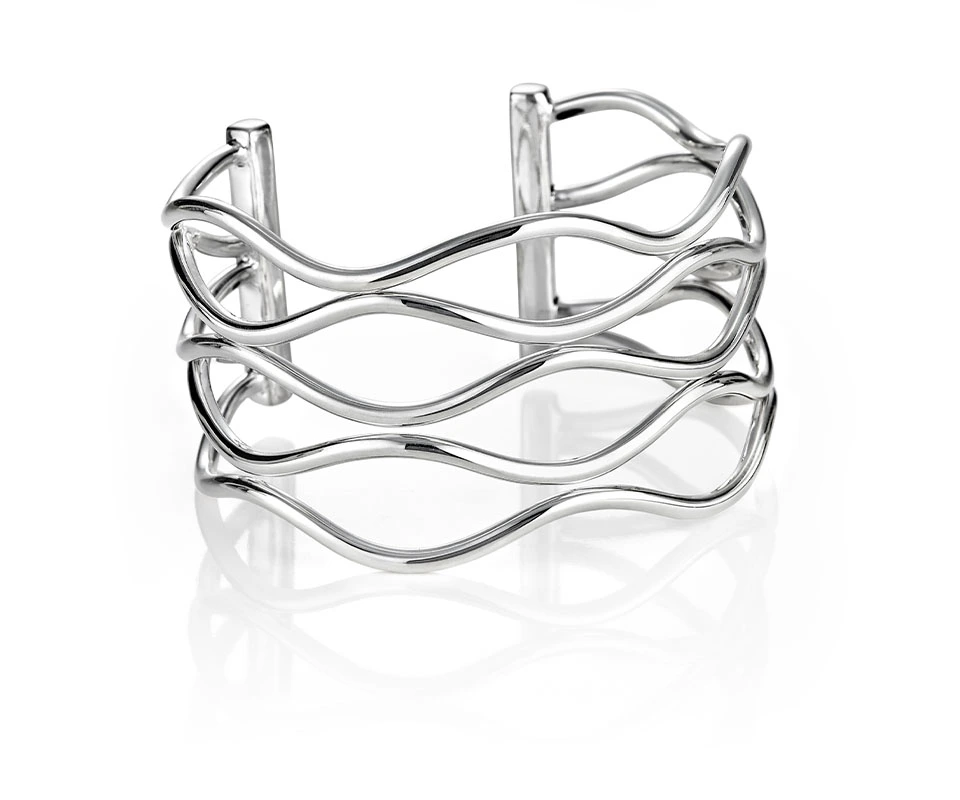
Silver has a storied legacy that stretches back thousands of years, making it a timeless classic. Known for its soft luster and cool, gray-white color, silver complements various designs.
Because silver is a naturally soft metal, the silver used in jewelry most often takes the form of sterling silver. Sterling silver is made by mixing an alloy of 92.5% pure silver with 7.5% other metals, like copper or nickel, to make it strong and durable enough for jewelry.
How to Tell the Difference between White Gold and Silver
Appearance and Style
White Gold
White gold offers a modern, sophisticated look that can mimic the appearance of platinum at a more affordable price. It consists of gold combined with elements like palladium, nickel or silver that “bleach” it.
White gold with less gold and higher alloy content will have a “whiter” hue, whereas white gold with more gold and less alloy content displays a slight yellow tint. Both will still appear faintly yellow unless they are plated with rhodium, which gives them the same bright white color.
White gold complements many gemstones and design styles, enhancing brilliant diamonds and colorful gemstones. Its bright, mirror-like finish is versatile and appealing, suitable for many high-end designs.
Silver
Silver is characterized by its luster and crisp, cool white appearance, which can often contain subtle gray undertones. Over time, silver may develop a patina. This natural aging process can highlight textural details, adding edge, depth and character to the metal. Some designers also oxidize sterling silver to give it a darker color that provides edge, drama and contrast in a piece.
Silver’s cool luster works beautifully with a broad spectrum of gemstones. It is especially popular in larger, statement pieces and is often used as settings for gemstones that are relatively more affordable, such as turquoise and amber.
Price
White Gold
Due to its composition and the complex processes required to create it, white gold typically has a higher price point than silver. The cost of white gold increases with the amount of gold in the alloy, meaning higher gold content leads to a higher price.
Silver
Silver is generally more affordable than white gold due to its abundance and less intricate processing requirements. The price of silver jewelry is influenced by the purity of the metal and the craftsmanship involved. Still, it remains significantly lower in price, making it an attractive option for those seeking beautiful jewelry at a more accessible price.
Durability and Scratch Resistance
White Gold
Alloy composition and protective rhodium plating make white gold more resistant to scratches than silver. This resilience makes it ideal for everyday wear, keeping its surface smooth and polished over extended periods of time.
Silver
Silver is naturally softer and more susceptible to scratches and dents than white gold. Silver jewelry requires gentle care and handling to maintain its delicate surface and detailed workmanship.
Tarnish and Maintenance
White Gold
The rhodium plating on white gold boosts its brightness and provides a barrier against tarnishing. Regular wear does not significantly affect its brilliant finish, although occasional re-plating will be necessary to maintain its brightness and protect it from wear.
Silver
Silver is prone to tarnishing when exposed to air and moisture, which can dim its radiant sheen over time. Frequent polishing and careful storage are essential to preserve the original beauty of silver jewelry, making it a bit more high-maintenance than white gold.
Like white gold, silver is sometimes plated with rhodium to give it a bright, mirror-like shine. Rhodium plating protects silver from tarnishing and can give jewelry the appearance of white gold at a lower cost.
Markings
White Gold
White gold is typically stamped with hallmarks like “14K,” “18K,” or “750,” which denote the gold content and authenticate the metal. Additional marks may include maker’s stamps or country of origin, which provide further identification and traceability. For example, a “14K” mark indicates that the jewelry is comprised of 58.3% gold and 41.7% other metals.
Silver
Silver jewelry often features purity marks such as “925,” “Sterling” or “999.” These markings indicate the purity of the silver used in the piece, ensuring it meets the required standards for fine jewelry.
For example, the “925” mark means that the silver is 92.5% pure. The remaining 7.5% typically consists of other metals, usually copper, which strengthen the silver. Also known as sterling silver, 925 is the most common standard for silver jewelry, providing a good balance between purity and durability.
A “999” mark means the silver is 99.9% pure, making it incredibly soft and susceptible to scratches and dents. This type of silver is often called fine silver. Due to its high purity, it is less common in jewelry that requires durability, like rings and bracelets.
Allergies and Skin Sensitivities
White Gold
Nickel, often used in white gold alloys, can cause allergic reactions for some people. Opting for nickel-free metals or high-purity 18K white gold, which generally contains less nickel, might be a better choice if you have sensitive skin. Always discuss your metal allergies with a GIA-trained jeweler to ensure you choose a hypoallergenic option that suits your needs.
Silver
Silver is often considered a good option for people with sensitive skin, but it’s not entirely hypoallergenic. Pure silver is generally safe, but sterling silver contains 92.5% silver and 7.5% other metals, usually copper or nickel. This addition of other metals enhances the durability of silver but can trigger allergic reactions in some people.
If you have sensitive skin or metal allergies, look for nickel-free silver jewelry or for silver jewelry that has been plated with a hypoallergenic metal, like rhodium, to help prevent reactions. Always check with a jeweler to understand the composition of the jewelry before purchasing it to ensure it meets your needs.
White Gold vs. Silver: How to Choose the Best Metal for Your Engagement Ring
Still unsure what metal to choose for your perfect engagement ring? Use this guide to compare the two metals and determine your best option.
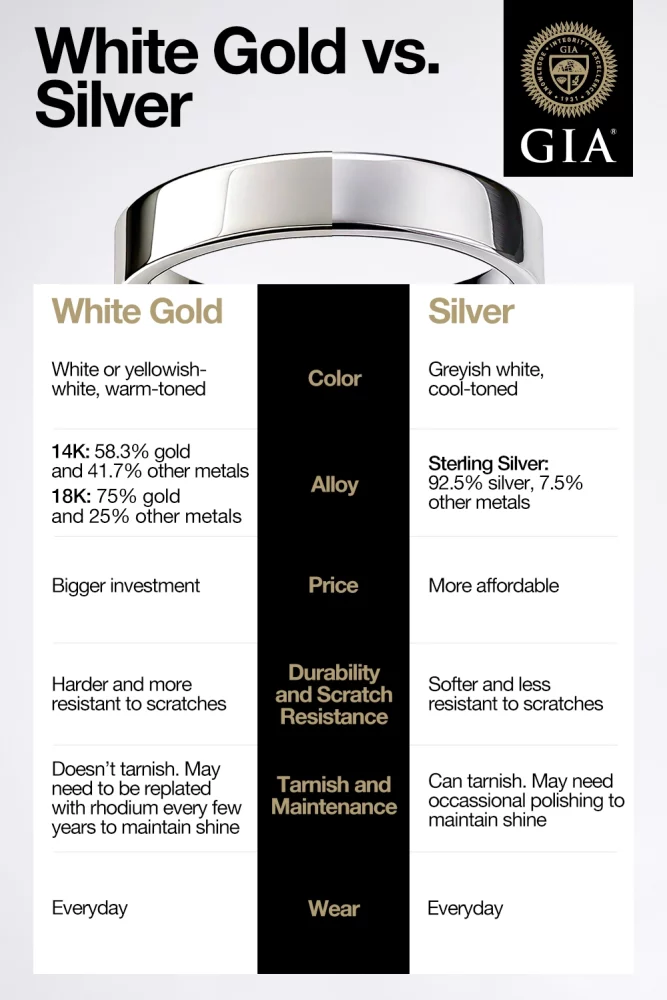
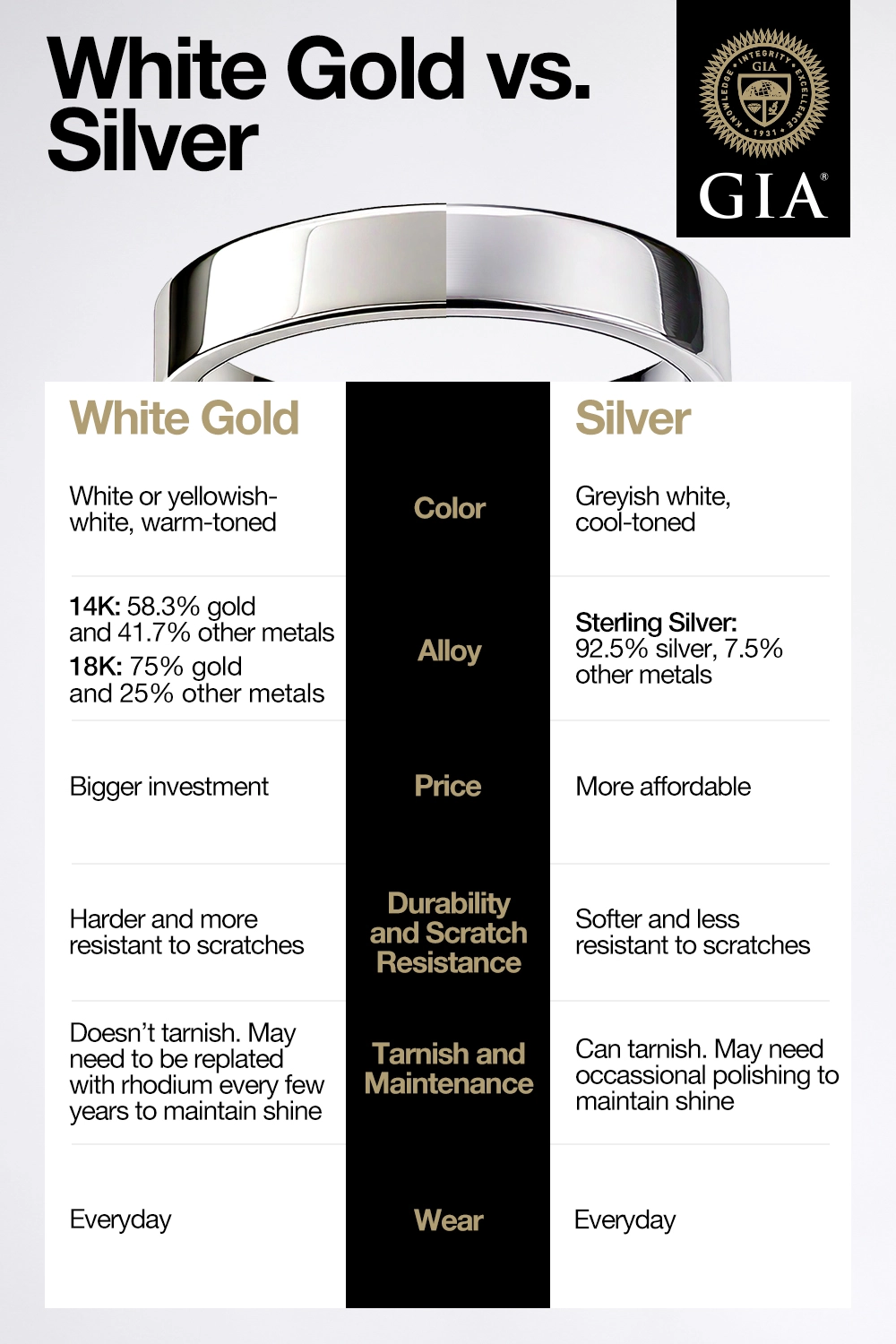
FAQ: White Gold vs. Silver
Is white gold or silver better for engagement rings?
When choosing between white gold and silver for an engagement ring, consider your lifestyle, budget and aesthetic preference. White gold is typically favored for engagement rings due to its durability and luxurious feel. It holds up better over time against daily wear and maintains its shine with less maintenance. Silver, while beautiful, is softer and more prone to tarnishing, requiring more care to keep it looking its best.
Is white gold more expensive than sterling silver?
Yes, white gold is generally more expensive than sterling silver. The higher cost of white gold can be attributed to its gold content and the complex processes involved in its creation. Gold is a more valuable material than silver, and the alloying and plating processes add to white gold’s cost. However, due to its longevity and appearance, the investment in white gold might be worthwhile for pieces like engagement rings or other jewelry intended for frequent wear.
Can you wear white gold in the shower?
It is not recommended to wear white gold in the shower. Although water alone will not harm the metal, regular exposure to water and chemicals in some soaps and shampoos can dull the rhodium finish. It’s best to remove white gold jewelry before showering to maintain its luster and minimize the need for re-plating.
Can you wear sterling silver in the shower?
Silver is not recommended for use in the shower. Like white gold, silver is not harmed by water per se, but frequent exposure to moisture can accelerate tarnishing, especially if the water contains chlorine or other harsh chemicals. To keep your silver looking its best, it’s a good idea to remove it before showering.
What Other Factors Should I Consider When Choosing My Ring Metal?
Weight: Silver is lighter and more affordable than white gold, so many people prefer silver for large, statement jewelry or for large earrings.
Gemstone Compatibility: Ensure that the metal you choose complements the gemstone in your ring. Many people set diamonds and high-value colored gemstones in white gold or platinum and use silver to complement gemstones such as citrine, amethyst and rose quartz.
Find Your Perfect White Gold or Silver Ring with Help from GIA
At the Gemological Institute of America (GIA), we offer expert knowledge and set global standards on gems and jewelry. Consumers, museums and auction houses alike rely on GIA reports for accurate, unbiased information on the identity and quality of gemstones.
Looking to buy a gem? Protect your purchase by ensuring it comes with a GIA report, and work with a GIA-trained jeweler for expert guidance. You can also explore our educational tools, such as the 4Cs of Diamond Quality and the GIA 4Cs Blog for diamond and jewelry buying tips.
